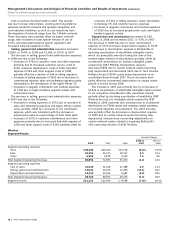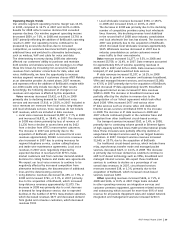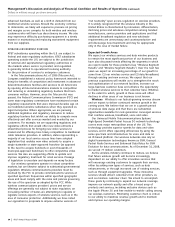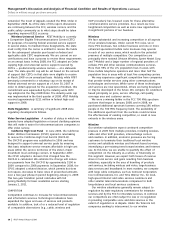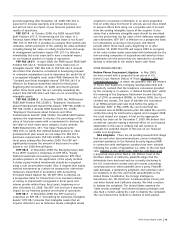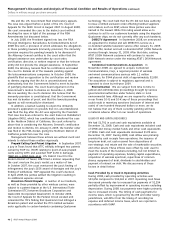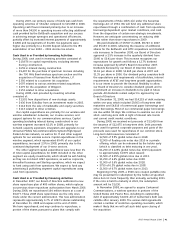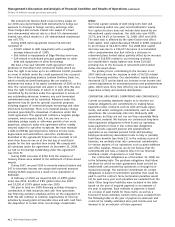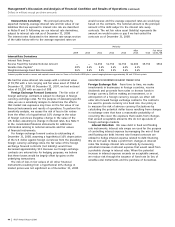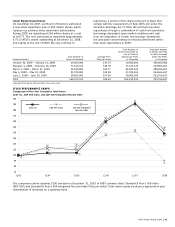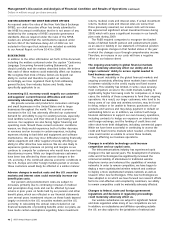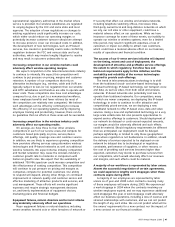AT&T Wireless 2008 Annual Report Download - page 39
Download and view the complete annual report
Please find page 39 of the 2008 AT&T Wireless annual report below. You can navigate through the pages in the report by either clicking on the pages listed below, or by using the keyword search tool below to find specific information within the annual report.
AT&T Annual Report 2008
| 37
subsidiaries’ networks and exchange local calls enter into
interconnection agreements with us. Any unresolved issues
in negotiating those agreements are subject to arbitration
before the appropriate state commission. These agreements
(whether fully agreed-upon or arbitrated) are then subject to
review and approval by the appropriate state commission.
Recently, in a number of the states in which we operate as
an ILEC, state legislatures or the state public utility commissions
have concluded that the voice telecommunications market
is competitive and have allowed for greater pricing flexibility
for non-basic residential retail services, including bundles,
promotions and new products and services. While it has been
a number of years since we have been allowed to raise local
service rates in certain states, some of these state actions
have been challenged by certain parties and are pending
court review.
In addition to these rates and service regulations noted
above, our wireline subsidiaries (excluding rural carrier
affiliates) operate under state-specific elective “price-cap
regulation” for retail services (also referred to as “alternative
regulation”) that was either legislatively enacted or authorized
by the appropriate state regulatory commission. Under
price-cap regulation, price caps are set for regulated services
and are not tied to the cost of providing the services or to
rate-of-return requirements. Price-cap rates may be subject
to or eligible for annual decreases or increases and also may
be eligible for deregulation or greater pricing flexibility if the
associated service is deemed competitive under some state
regulatory commission rules. Minimum customer service
standards may also be imposed and payments required if
we fail to meet the standards.
We continue to lose access lines due to competitors
(e.g., wireless, cable and VoIP providers) who can provide
comparable services at lower prices because they are not
subject to traditional telephone industry regulation (or the
extent of regulation is in dispute) and consequently have
lower cost structures. In response to these competitive
pressures, for several years we have utilized a bundling
strategy that rewards customers who consolidate their
services (e.g., local and long-distance telephone, DSL,
wireless and video) with us. We continue to focus on bundling
wireline and wireless services, including combined packages
of minutes and video service through our AT&T U-verse
service and our relationships with satellite television providers.
We will continue to develop innovative products that
capitalize on our expanding fiber network.
Additionally, we provide local, domestic intrastate and
interstate, international wholesale networking capacity and
switched services to other service providers, primarily large
Internet Service Providers using the largest class of
nationwide Internet networks (Internet backbone), wireless
carriers, CLECs, regional phone ILECs, cable companies
and systems integrators. These services are subject to
additional competitive pressures from the development
of new technologies and the increased availability of
domestic and international transmission capacity.
The introduction of new products and service offerings
and increasing satellite, wireless, fiber-optic and cable
transmission capacity for services similar to those provided
by us continues to provide competitive pressures. We face
a number of international competitors, including Equant,
British Telecom and SingTel; as well as competition from
a number of large systems integrators, such as Electronic
Data Systems.
Advertising & Publishing
Our advertising & publishing subsidiaries face competition
from approximately 100 publishers of printed directories in
their operating areas. Competition also exists from other
advertising media, including newspapers, radio, television and
direct-mail providers, as well as from directories offered over
the Internet. Through our wholly-owned subsidiary, YPC, we
compete with other providers of Internet-based advertising
and local search.
ACCOUNTING POLI C I ES AND STANDA RDS
Significant Accounting Policies and Estimates Because of
the size of the financial statement line items they relate to,
some of our accounting policies and estimates have a more
significant impact on our financial statements than others.
The policies below are presented in the order in which the
topics appear in our consolidated statements of income.
Allowance for Uncollectibles We maintain an allowance
for doubtful accounts for estimated losses that result from
the failure of our customers to make required payments.
When determining the allowance, we consider the probability
of recoverability based on past experience, taking into account
current collection trends as well as general economic factors,
including bankruptcy rates. Credit risks are assessed based
on historical write-offs, net of recoveries, and an analysis of
the aged accounts receivable balances with reserves generally
increasing as the receivable ages. Accounts receivable may
be fully reserved for when specific collection issues are
known to exist, such as pending bankruptcy or catastrophes.
The analysis of receivables is performed monthly and the
bad-debt allowances are adjusted accordingly. A 10% change
in the amounts estimated to be uncollectible would result
in a change in uncollectible expense of approximately $130.
Pension and Postretirement Benefits Our actuarial
estimates of retiree benefit expense and the associated
significant weighted-average assumptions are discussed in
Note 11. One of the most significant of these assumptions
is the return on assets assumption, which was 8.50% for the
year ended December 31, 2008. In setting the long-term
assumed rate of return, management considers capital
markets future expectations and the asset mix of the plans’
investments. The actual long-term return can, in relatively
stable markets, also serve as a factor in determining future
expectations. However, the dramatic adverse market
conditions in 2008 have skewed the calculation of the
long-term actual return; the actual 10-year return was
4.21% through 2008 compared with 9.18% through 2007.
The severity of the 2008 losses will make the 10-year actual
return less of a relevant factor in management’s evaluation
of future expectations. Based on future expectations and the
plans’ asset mix, management has left unchanged the
long-term assumed rate of return for 2009. If all other factors
were to remain unchanged, we expect that a 1.0% decrease
in the assumed long-term rate of return would cause 2009



